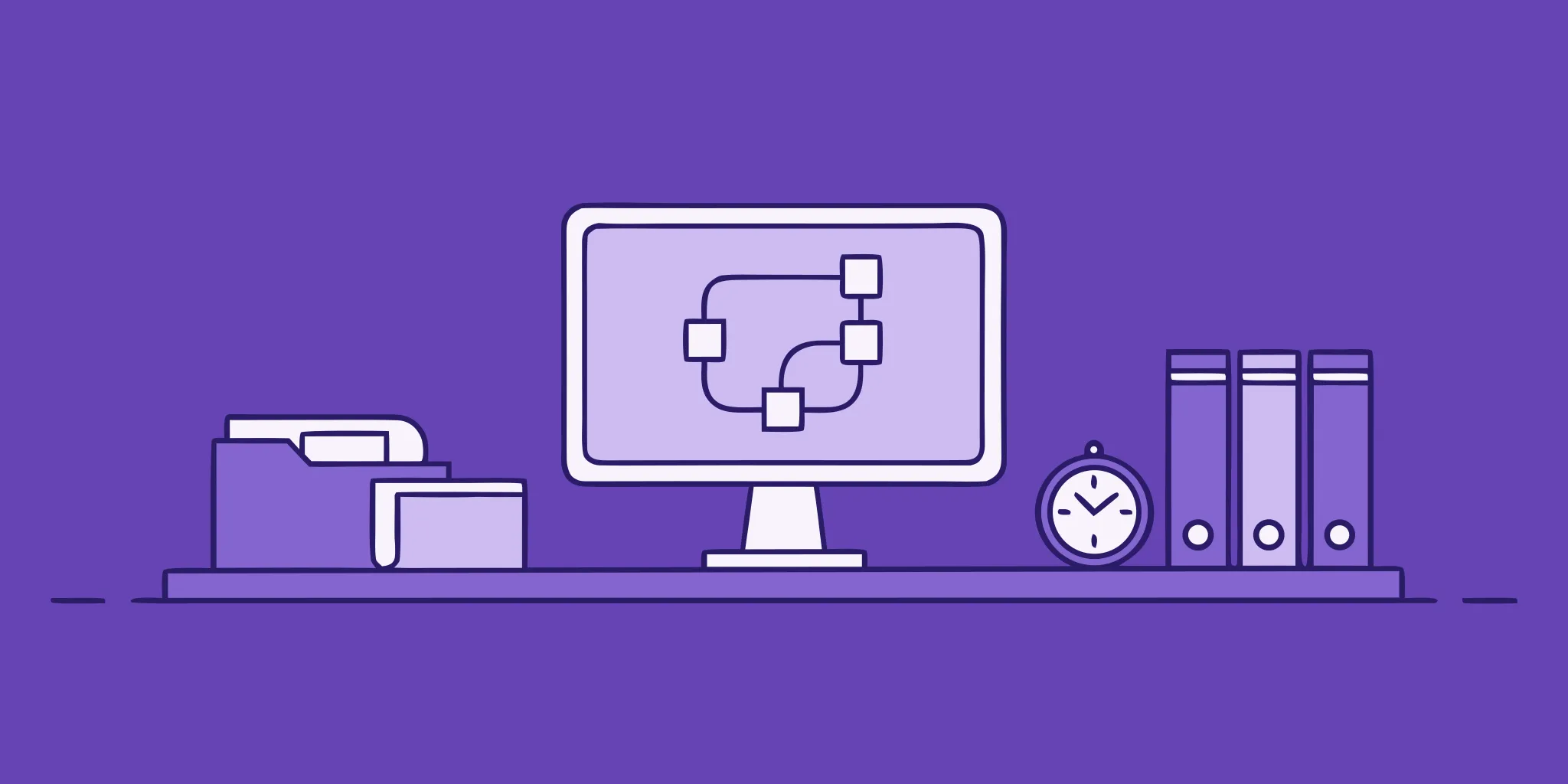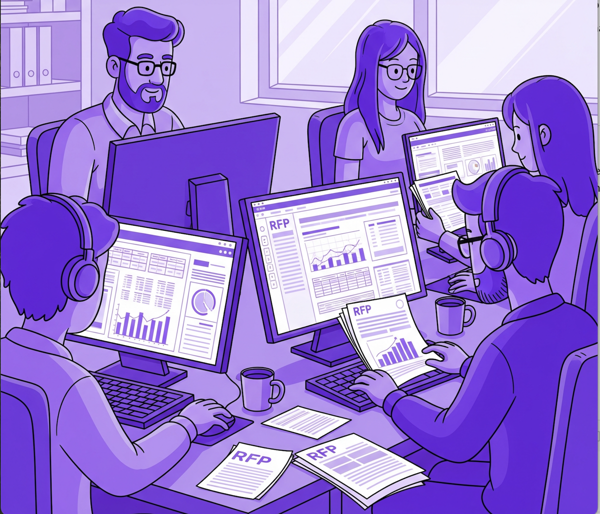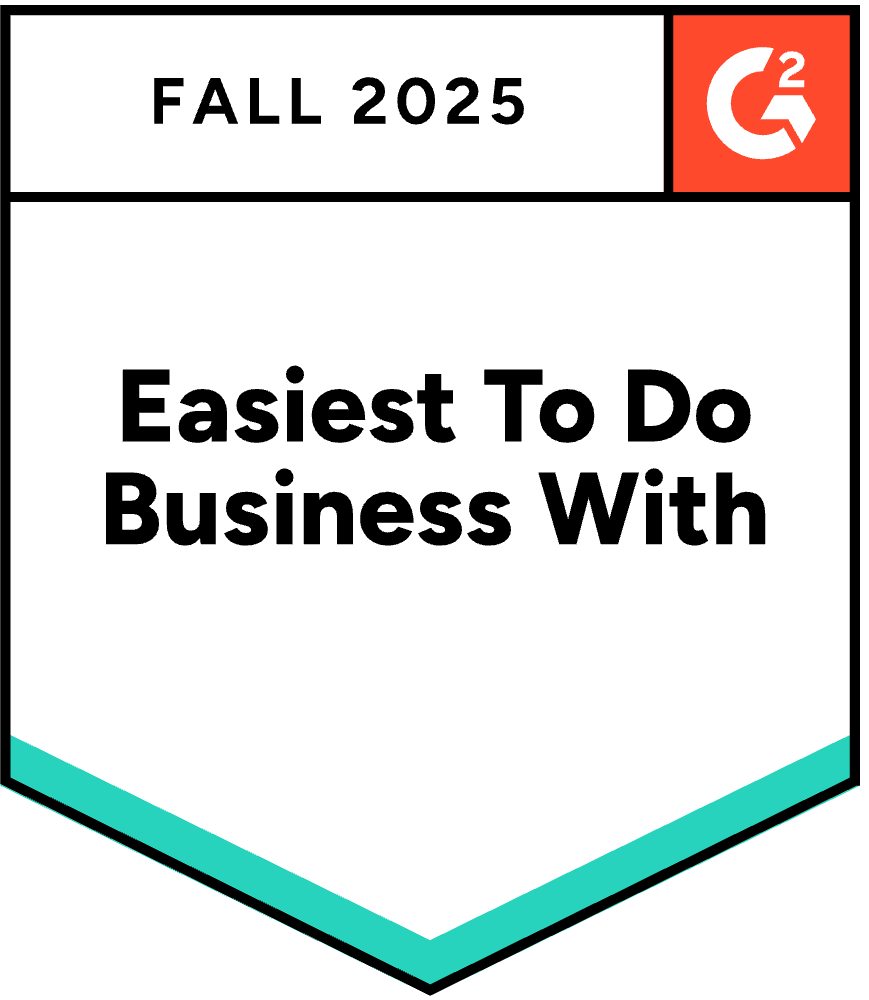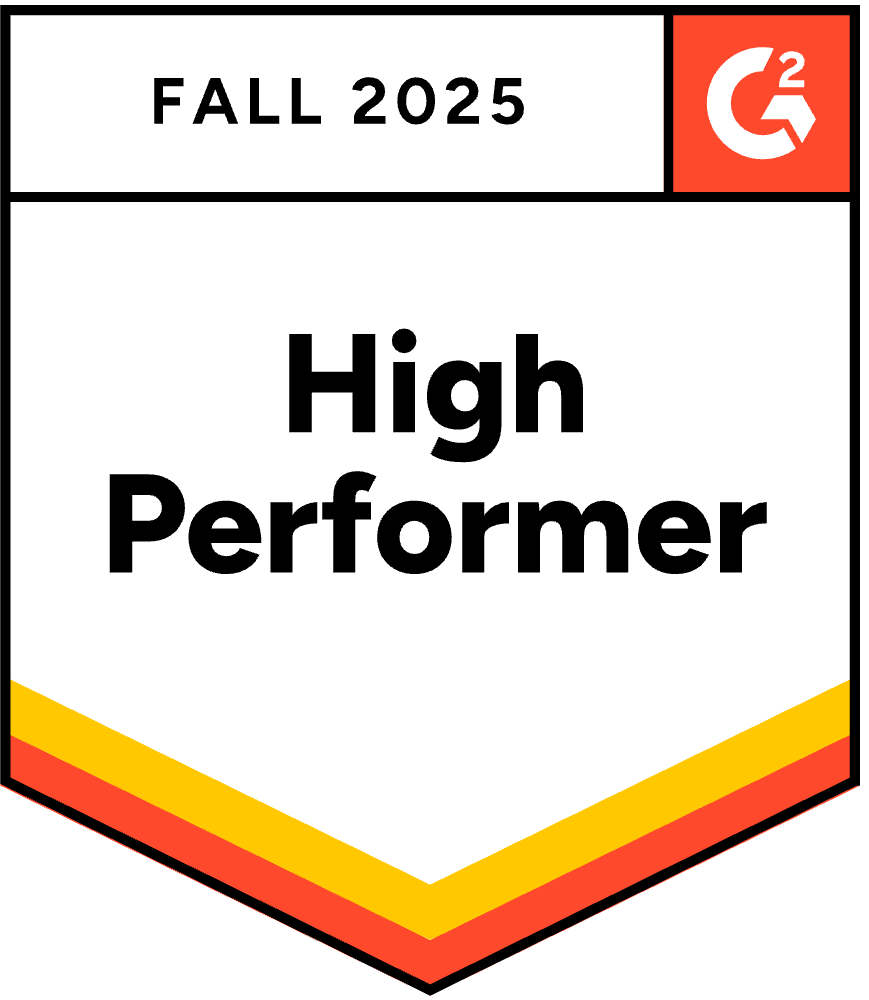How to Automate RFP Responses: A Beginner's Guide
November 14, 2025
By
Evie Secilmis

Let's be honest: the traditional RFP response process is broken. It creates information silos, leads to inconsistent messaging, and burns out your best employees with repetitive, low-value work. Instead of being a strategic part of the sales cycle, it becomes a bottleneck. The solution isn't to work harder; it's to work smarter. This is where learning how to automate RFP responses changes the game entirely. By implementing the right software, you can create a single source of truth for your content, streamline collaboration, and empower your team to respond to more opportunities with higher quality, directly impacting your win rates and revenue.
Key Takeaways
- Reclaim your team's time for strategy: Let automation handle the repetitive task of finding answers so your experts can dedicate their time to customizing proposals and crafting the narrative that wins the deal.
- Build a single source of truth for your content: A well-organized content library is the engine behind automation, ensuring every proposal uses accurate, consistent, and pre-approved information, which builds trust with potential clients.
- Use data to continuously improve your process: Treat your content library as a living resource by scheduling regular updates, and use your software’s analytics to track performance, identify content gaps, and refine your strategy over time.
What is RFP Automation, and Why Does It Matter?
Let’s start with a simple definition. RFP automation is the use of smart technology to streamline how you respond to a Request for Proposal (RFP). Instead of manually digging through old documents and piecing together answers, automation software helps you create high-quality proposals faster. Think of it as a central brain for all your company’s knowledge, ready to help you find the perfect answer in seconds.
This isn't just about saving time; it's about changing how your team approaches the entire sales process. When you automate the tedious, administrative parts of responding to RFPs, you free your team to focus on what really matters: crafting strategic, personalized proposals that stand out and win deals. It transforms a process that often feels like a necessary evil into a powerful, strategic advantage. By centralizing information and speeding up the initial draft, you empower your best people to do their best work, ensuring every proposal is accurate, consistent, and compelling. It’s the key to scaling your proposal efforts without burning out your team or sacrificing quality. Ultimately, it allows you to respond to more opportunities with higher quality, directly impacting your win rates and revenue.
The Problem with the Traditional RFP Process
If you’ve ever responded to an RFP manually, you know the drill. It’s a frantic search through old proposals, shared drives, and endless email threads, all to find that one perfect answer you know you’ve written before. The process is slow, repetitive, and often feels like a massive copy-and-paste project. In fact, about 80% of the content in any given RFP response is boilerplate information you’ve used before.
This manual approach doesn't just drain your team's time and energy; it creates information silos. The marketing team has one version of a product description, sales has another, and legal has specific compliance language that has to be included. This lack of a single source of truth leads to inconsistent, and sometimes inaccurate, proposals that can cost you the deal.
How Automation Changes the Game
RFP automation flips the script entirely. Instead of you searching for answers, the software does it for you. Modern RFP tools use AI to scan an incoming request, understand the questions, and instantly suggest the most relevant, up-to-date answers from your content library. This means your first draft can be ready in minutes, not days.
This efficiency has a massive impact. Teams that use automation submit 43% more proposals and have 25% more time to personalize them for each client. By taking care of the repetitive work, the software frees up your experts to focus on strategy, tailor responses, and build stronger relationships with potential customers. They can shift from being content hunters to strategic advisors, which is a much better use of their talent and time.
How Does RFP Response Automation Actually Work?
So, how does this software actually take a process that used to take weeks and shrink it down to days or even hours? It’s not magic—it’s a smart combination of organized content, intelligent technology, and streamlined teamwork. Think of it as giving your team a super-powered assistant who handles all the tedious, repetitive parts of responding to an RFP. This lets your experts focus on strategy and crafting the perfect proposal. The entire process generally breaks down into three core functions working together: a central library for your information, AI to find the right answers, and automated workflows to keep the project moving smoothly from start to finish.
At its core, RFP automation software transforms a chaotic, manual process into a well-oiled machine. Instead of frantically searching for information across scattered documents and relying on institutional memory, your team gets a structured environment built for efficiency. The system first ingests and organizes all your critical company information. Then, when a new proposal request arrives, it uses powerful AI to parse the questions and instantly match them with the best-approved answers. Finally, it wraps the entire project in a layer of project management, ensuring every task is assigned, tracked, and completed on time. It’s a holistic approach that addresses the biggest pain points of the traditional RFP process: finding information, writing responses, and managing collaboration.
Your Central Knowledge Library
Imagine never having to dig through old emails, shared drives, or outdated documents to find an answer again. That’s the power of a central knowledge library. This is the heart of any RFP automation platform. It’s a single, organized place where all your company’s approved information lives—from security protocols and product specs to case studies and team bios. Instead of writing answers from scratch every time, your team can pull from this pre-vetted content. Your subject matter experts simply need to review and approve the information, ensuring every response is accurate and consistent. This knowledge management approach becomes your single source of truth for every proposal.
AI That Finds the Perfect Answers
Once your knowledge library is set up, the artificial intelligence gets to work. When a new RFP comes in, the software uses AI and machine learning to read and analyze the questions. It then intelligently searches your library to find and suggest the most relevant answers for each query. A powerful AI deal desk solution like Iris can generate a complete first draft in minutes, not days. The AI is designed to understand context and nuance, so it doesn't just match keywords; it finds the best possible response. This is where the real time-saving happens, as the system does the heavy lifting of finding and populating answers.
Automated Workflows That Keep Things Moving
Beyond just finding answers, RFP automation software acts as your project manager. It streamlines the entire collaboration process with automated workflows. You can assign specific questions to subject matter experts, set deadlines, and track progress all within the platform. The system sends automatic notifications and reminders to keep everyone on schedule, so you don't have to chase down team members for approvals or reviews. This structure ensures nothing falls through the cracks and frees up your team from administrative busywork. They can spend their valuable time on strategic tasks that actually help win the deal, rather than managing a complicated project timeline.
What Are the Real Benefits of Automating RFP Responses?
Switching to an automated RFP process does more than just speed things up—it fundamentally changes how your team approaches new business opportunities. Instead of getting bogged down by manual, repetitive tasks, your team can focus on strategy and creating proposals that truly stand out. Think of it as giving your experts the tools they need to do their best work, every single time. The benefits ripple across your entire sales cycle, from initial response to final review, leading to better proposals, a more efficient team, and ultimately, more wins. Let's break down what you can really expect when you bring automation into your workflow.
Win Back Time and Get More Done
The most immediate benefit you'll notice is the sheer amount of time your team gets back. Manually searching for answers, copying and pasting from old documents, and chasing down subject matter experts eats up countless hours. RFP automation handles that heavy lifting, dramatically cutting down the time spent on routine tasks. In fact, some organizations find they can cut their response time in half. This efficiency means your team can handle a higher volume of proposals without burning out. Studies show that companies using RFP software respond to 43% more RFPs annually, creating significantly more opportunities to bring in revenue.
Improve Proposal Quality and Consistency
Have you ever submitted a proposal only to realize later that it contained outdated information or inconsistent branding? Automation solves this by creating a central knowledge library that acts as your single source of truth. Every piece of content—from company boilerplate to complex technical answers—is stored, approved, and easily accessible. This ensures that every proposal that goes out the door is accurate, on-brand, and professional. This consistency not only makes your proposals clearer and more persuasive but also builds trust with prospective clients by presenting a polished and unified front from the very first interaction.
Let Your Team Focus on What They Do Best
Let's be clear: AI is here to assist your team, not replace it. The goal of automation is to free your talented people from tedious, low-value work so they can apply their expertise where it matters most. With an AI deal desk solution, your sales strategists can spend more time tailoring the proposal to the client's specific needs, your writers can focus on crafting a compelling narrative, and your subject matter experts can provide nuanced, high-impact answers instead of answering the same questions over and over. Humans are still essential for the critical thinking, customization, and final review that wins deals. Automation simply handles the rest.
What to Look For in RFP Automation Software
Choosing the right RFP automation software can feel like a big decision, but it really comes down to a few key capabilities. You want a tool that not only speeds up your process but also makes your team's life easier and your proposals stronger. Think of it as hiring the most efficient assistant you've ever had. The best platforms are smart, connected, and give you the data you need to win more deals. Let’s break down the must-have features.
Smart Content Management and Collaboration
The heart of any great RFP tool is its ability to manage your content. Instead of digging through old documents and shared drives, your team should have a central "content library" where all your best answers are stored and organized. Look for software that uses AI to help you find the perfect response in seconds. This solves the problem of knowledge being stuck in different departments by creating one source of truth. A strong platform will also have collaboration features that let your subject matter experts easily review, edit, and approve content, ensuring every proposal is accurate and polished.
Seamless Integrations and Workflows
Your RFP software shouldn't operate on an island. To be truly effective, it needs to connect with the other tools your team already relies on every day, like your CRM, cloud storage, and communication apps. These seamless integrations create a smooth workflow, eliminating the need to constantly switch between programs or manually transfer information. This connectivity ensures that everyone is on the same page and that your proposal process fits naturally into your broader sales operations. When your tools talk to each other, your team can focus on strategy instead of tedious administrative tasks.
Clear Analytics and Reporting
How do you know if your proposals are actually working? The right software will give you clear answers. Look for a tool with robust analytics that track key metrics like which content is used most often, how quickly you’re responding, and what your win rates are. This data is invaluable for understanding your performance and identifying areas for improvement. Over time, these insights allow you to refine your content and strategy, making each proposal better than the last. It’s about turning your response process from a guessing game into a data-driven engine for growth.
Top RFP Automation Tools on the Market
Choosing the right software can feel overwhelming, but the good news is there are fantastic options out there designed for different team needs. Whether you're a small team just getting started or a large enterprise looking to refine your process, there's a tool that can help you ditch the manual work and focus on winning more deals. Let's walk through some of the top players in the RFP automation space so you can find the perfect fit for your team.
HeyIris.ai
Think of HeyIris.ai as your team's AI-powered strategist. It goes beyond just storing answers; it dynamically creates precise, context-aware responses for each new proposal. This is a game-changer because it understands the nuances of each RFP, helping you craft tailored proposals without the repetitive copy-and-paste grind. It’s designed for teams that want to move past simple automation and leverage AI to create more strategic, effective responses. By handling the heavy lifting, it frees up your experts to focus on the high-level strategy that actually closes deals, which is how you can really improve your win rate.
Loopio
Loopio is a fantastic choice if your main goal is to create a single source of truth for all your proposal content. It excels at organizing your information and automating the more repetitive parts of the response process. Teams that already have a good handle on their content but need a better system to manage and deploy it will find Loopio incredibly helpful. Users have seen huge efficiency gains, with some reporting they can respond to 27% more RFPs. It’s a powerful platform for streamlining your workflow and ensuring everyone is pulling from the most up-to-date, approved content.
Arphie
If you're looking for a straightforward and user-friendly way to get your RFP process organized, Arphie is a solid contender. It focuses on the essentials: a centralized content library and simple collaboration tools. This platform is designed to get your team on the same page quickly, making it easy to manage responses and keep track of progress without a steep learning curve. Arphie is a great starting point for teams that need to build a more structured process from the ground up and want a tool that simplifies content management and enhances teamwork.
RFP360
For teams where collaboration is everything, RFP360 is built to shine. It’s designed to function as a real-time, shared workspace for your entire proposal team. The platform makes it easy for multiple people to work together seamlessly, manage content effectively, and automate tasks within a clear, collaborative workflow. If your current process is slowed down by communication gaps or version control issues, this tool can help bring everyone together. It’s particularly useful for larger organizations or complex proposals that require input from many different departments, ensuring a smooth and efficient group effort.
How to Successfully Implement RFP Automation
Bringing RFP automation into your workflow is more than just flipping a switch; it’s about setting up your team and your new tool for a successful partnership. A thoughtful implementation process ensures you get the most value from your investment right away and avoid common roadblocks. Instead of just handing over the keys, you’re building a new, more efficient system from the ground up.
The good news is that a successful rollout boils down to three core steps. First, you’ll create a central hub for all your best content, making it easy for the AI to find winning answers. Next, you’ll define how your team works together within the platform, clarifying roles and automating the review process. Finally, you’ll get everyone comfortable with the new software, showing them how it makes their jobs easier, not harder. By focusing on these key areas, you can ensure a smooth transition and start seeing a return on your investment faster.
Build and Organize Your Content Library
Think of your content library as the single source of truth for your entire organization. It’s a centralized, searchable database that houses all your best, most up-to-date answers to common RFP questions. Instead of digging through old proposals and scattered documents, your team will have a go-to resource. The first step is to populate this library by gathering your strongest content from past RFPs, security questionnaires, and marketing materials. While this initial setup requires some effort, it’s the foundation of the whole system. A well-organized knowledge library is what allows the AI to instantly pull accurate, approved information, giving your team a massive head start on every proposal.
Set Up Your Workflows and Team Permissions
Automation is just as much about streamlining your process as it is about finding content. Before you start your first project, take the time to map out your ideal workflow within the software. Who needs to review technical questions? Who gives the final sign-off on pricing? You can set up custom approval chains and assign specific roles and permissions to each team member. This eliminates the guesswork and endless email chains. The software can then automatically route questions to the right subject matter experts and send notifications when a task is due. This creates a clear, repeatable process that keeps every proposal moving forward without constant manual check-ins.
Train Your Team for a Smooth Transition
New technology can feel intimidating, so it’s crucial to get your team on board from day one. Start by clarifying that the AI is here to help them, not replace them. It’s designed to handle the repetitive, time-consuming tasks so your experts can focus on what they do best: strategy, customization, and relationship-building. Emphasize that human oversight is still essential. The AI provides a strong first draft, but your team’s expertise is what turns a good proposal into a winning one. Run a few training sessions, walk through a sample RFP together, and create clear guidelines. A little hands-on practice will build confidence and help everyone see the benefits for themselves.
What Challenges Can You Expect with RFP Automation?
Switching to any new tool can feel like a big step, and RFP automation is no different. It’s smart to go in with your eyes open, ready for a few potential bumps along the way. The good news is that most of the common worries are based on outdated ideas about automation. By understanding the reality and planning ahead, you can make the transition smooth and start seeing results faster than you might think.
Common Myths About Automation
Let's clear the air on a few common myths. First, the idea that automation will replace your team is simply not true. Think of it as a powerful assistant that handles the repetitive work, freeing up your experts for strategic tasks like customizing proposals and final reviews. Another concern is cost, but the return on investment is often immediate. When you factor in the time saved and the increase in deal volume and win rates, the software quickly pays for itself. Finally, modern tools are far from limited; they are comprehensive platforms for managing content, collaborating with your team, and handling all sorts of sales documents.
How to Overcome Implementation Hurdles
A successful rollout starts with choosing the right tool and setting it up for your team's needs. Look for a platform that can automatically generate first drafts and uses a smart content library to pull the most relevant, up-to-date answers. Your team should always be able to preview and edit content before it goes into a proposal. Even with the most advanced AI, human oversight is essential for quality control and personalization. Getting your content library organized from the start and establishing clear workflows will make the transition much easier for everyone involved. A well-planned implementation process ensures your team can hit the ground running.
Best Practices for Long-Term RFP Automation Success
Bringing RFP automation software into your workflow is a huge step forward, but the journey doesn’t end there. Getting the most out of your new tool requires a little ongoing care and attention. Think of it less like a "set it and forget it" solution and more like a powerful engine that needs regular tune-ups to perform at its best. By building a few simple habits, you can ensure your team continues to save time, improve quality, and win more deals for years to come. These practices aren't complicated, but they are the key to turning a good investment into a game-changing one.
Keep Your Content Accurate and Up-to-Date
Your automation tool is powered by your content library, which means the quality of your outputs depends entirely on the quality of your inputs. An outdated or inaccurate knowledge base is the fastest way to undermine your success. To prevent this, treat your content library as a living resource. Schedule regular reviews—quarterly is a great starting point—and assign ownership of different sections to your subject matter experts. This way, your product team is responsible for product answers, your security team handles compliance, and so on. The best AI deal desk solutions can even help by proactively flagging content that may be getting stale, giving you a heads-up before it causes issues in a proposal.
Measure Your Performance and Keep Improving
One of the most powerful aspects of RFP automation is the data it provides. Don't let those insights go to waste. Use your software’s analytics to track key metrics like win rates, response times, and which pieces of content are used most frequently. This data tells a story about what’s working and where you have opportunities to get better. For example, if you notice you’re constantly writing new answers about a certain feature, that’s a clear sign you have a content gap to fill. This data-driven approach creates a powerful feedback loop, helping you refine your content and strategy over time. It’s how leading teams consistently improve their win rates and make smarter, more informed decisions.
Related Articles
- Step-by-Step Guide to RFP Automation
- How to Automate the RFP Response Process in 4 Steps
- RFP Automation: A Buyer's Guide for Small Business
- Streamlining Your RFQ Process with Automation
Frequently Asked Questions
Will RFP automation software write the entire proposal for me? Not exactly, and that’s actually a good thing. Think of the software as your brilliant assistant. It handles the heavy lifting by generating a complete and accurate first draft in minutes, pulling the best answers from your content library. This frees you from the tedious work so you can focus on the high-value strategy—tailoring the narrative, adding personal touches, and ensuring the proposal speaks directly to the client’s unique needs. Your expertise is still the secret ingredient that wins the deal.
How much time does it really take to get started with one of these tools? The initial setup does require some focused effort upfront, as you'll be gathering your best content to build your central knowledge library. However, the time you invest here pays for itself almost immediately. Once your core information is organized, you'll start saving hours on every single proposal. Most teams find that the long-term time savings and efficiency gains far outweigh the initial work of getting everything in place.
Is this kind of software only useful for large enterprise teams? While large companies certainly benefit, automation can be a game-changer for smaller, growing teams. It allows a small team to operate with the power and efficiency of a much larger one, responding to more opportunities without sacrificing quality. It helps level the playing field, giving you the bandwidth to compete for deals you might have previously passed on simply because you didn't have the resources.
What if our answers need to be customized for every single client? This is where automation becomes a true strategic advantage. Most proposals contain about 80% standard information and 20% custom content. The software quickly handles that 80%, giving your team back the time and mental energy to focus entirely on the critical 20%. Instead of spending days hunting for boilerplate answers, your experts can use that time to craft thoughtful, client-specific responses that show you truly understand their business.
Can these tools be used for documents other than RFPs? Yes, absolutely. While "RFP" is often in the name, most modern platforms are designed to handle a wide variety of business documents. You can use them to respond to Security Questionnaires, Due Diligence Questionnaires (DDQs), Requests for Information (RFIs), and even to help draft Statements of Work (SOWs). The core function of having a central library of approved answers is valuable any time you need to provide accurate, consistent information quickly.
Share this post
Link copied!



















